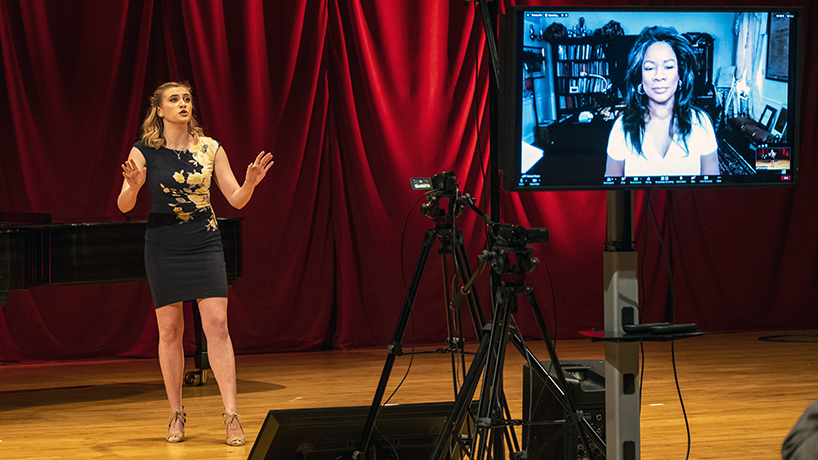
UMSL senior Lexi Neal sings the Habanera aria from “Carmen” during a masterclass with Denyce Graves held virtually on Feb. 18. (Photo by August Jennewein)
Even the most accomplished among us feel awe in front of our heroes.
That extends even to Denyce Graves, the soprano and a recipient of the Grand Prix Lyrique who has sung on stages across the world and earned the moniker “operatic superstar” from USA Today.
On Feb. 18, she shared such a moment with the University of Missouri–St. Louis community during a virtual Black History Month event “Trailblazers in Opera,” sponsored by Opera Theatre of St. Louis and the Des Lee Fine Arts Education Collaborative.
It was 1991, and Graves had just won the Marian Anderson Award and was in Denbury, Connecticut, to sing at the Ives Concert Park when she met the prize’s namesake.
“I had the great fortune of going to her home and meeting her and chatting with her beforehand,” Graves said. “But one of the things that made such a huge impression on me is that I remember learning about her when I was in fourth grade. For me, it was as if I stepped into the history books. I said, ‘How can you still be here? I learned about you when I was a little girl.’
“That was an incredible weekend, to have been in her company, to have audience with her and to be the recipient of so many wonderful gifts that she bestowed on me and that she’s given to the whole world.”
Graves, the Rosa Ponselle Distinguished Faculty Artist at the Johns Hopkins University Peabody Institute, shared history, insights and memories of Anderson, the pioneering vocalist who was the first Black individual to perform at the Metropolitan Opera in 1955. Afterward, Graves gave an opera masterclass with UMSL senior Lexi Neal and students from area high schools in the Blanche M. Touhill Performing Arts Center.
UMSL E. Desmond Lee Endowed Professor of Music Education Michael Smith and OTSL Director of Education and Community Engagement Allison Felter hosted the event. Students and teachers from Cardinal Ritter College Prep High School, Cor Jesu Academy, Gateway Middle School and Normandy High School tuned in virtually.
Graves began her talk by introducing Anderson as a shy, private woman whose tremendous voice and circumstances propelled her to become a trailblazer in overcoming racial prejudice.
In 1939, the Daughters of the American Revolution denied Anderson the opportunity to sing in Constitution Hall in Washington, D.C. Instead, she performed on the steps on the Lincoln Memorial with 75,000 in attendance.
“She became the face and the poster woman for the civil rights movement, which is not something that she wanted to do,” Graves said. “But she had this voice. She had this incredible instrument that carried with it, in its DNA, so much information about who she was and what was really in her heart. That was what she wanted everybody to unite and to love each other and to respect each other. I swear you can hear that in her singing.”
Audiences, comprised of people with disparate views, political and otherwise, are united by the music Graves said. She pointed to the community work she’d done with OTSL in the wake of Michael Brown’s death.
“Let music be that force that brings us all together so that we can hear each other’s perspectives,” she said. “That’s why music is so great.”
Graves recalled her nerves upon meeting Anderson and the surprise felt upon noticing the contrast between Anderson’s still powerful voice and tiny figure, much like the late Associate Justice of the Supreme Court Ruth Bader Ginsburg.
When the United States Postal Service commemorated a stamp in Anderson’s honor, Graves sang at the event, held at the DAR Memorial Continental Hall at Constitution Hall.
“Eleanor Roosevelt was a big champion of Marian Anderson’s and said that she would dissolve her association with the Daughters of the American Revolution if they didn’t make repairs,” Graves said. “What we saw happening through this event was the uniting and the coming together of all Americans. This was one of her greatest gifts, besides the beauty of that magnificent voice.”
The event closed with Graves answering questions from the virtual participants.
She discussed Anderson’s beginnings and inspiration. Though Anderson is known as the first Black women to sing at the Metropolitan Opera, there were many Black women opera singers that preceded her including Sissieretta Jones and Mary Cardwell Dawson, founder of the National Negro Opera Company.
Anderson began her career singing in church, where her beautiful voice was undeniable, and she had the support of that community in pursuing her career. Graves recalled reenacting Anderson’s repertoire and being impressed by its sheer range and thinking that Anderson, classified as a contralto, truly might have been a soprano.
“She came along at a time when racism was really, really, really very present,” Graves said. “She would not be viewed as a leading lady in an opera house, and that would be assigned to the sopranos, that it was easier to say that she had a contralto. I have no basis for this, except this is my own impression, because I’ve sung some of her material.”
The final question came from Felter, asking Graves to speak to the courage that Anderson must have possessed to face racial indignities and challenges and transcend them.
Graves touched on what Anderson faced and her background growing up in the church, which gave her spiritual strength and a strong foundation.
“There in the theater, all of those walls and all of those facades melt away, and our hearts and we are made pure from being in the presence of something that’s great,” Graves said. “That’s what art has the strength and the power to do. I think that Marian Anderson was able to do that with just the sheer beauty of her voice because it was undeniable. When she opened that voice to sing, you forgot.”














